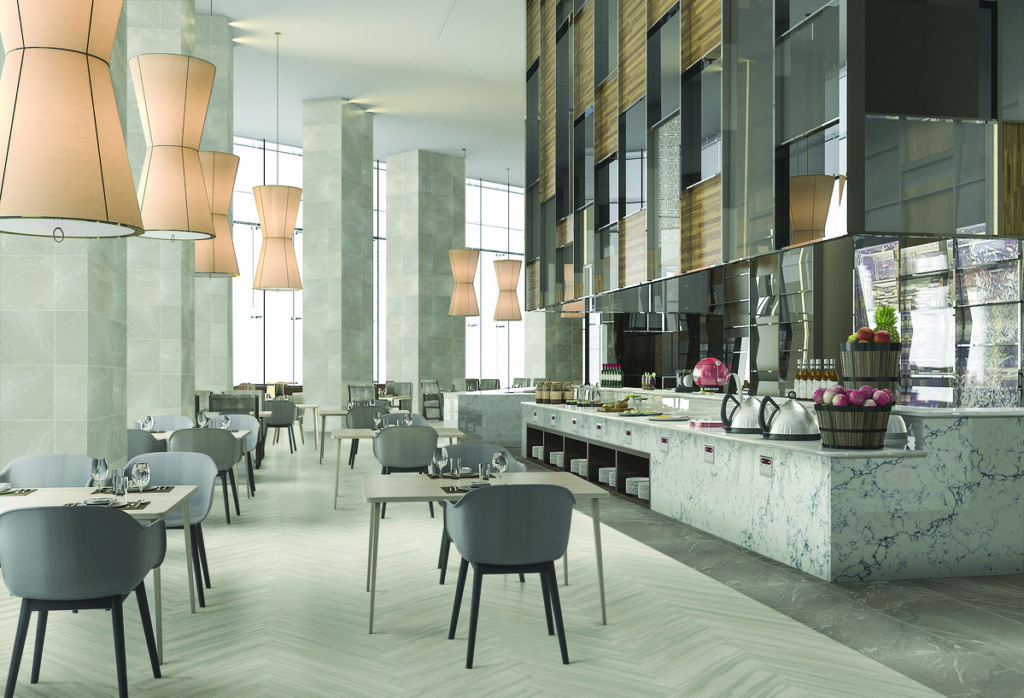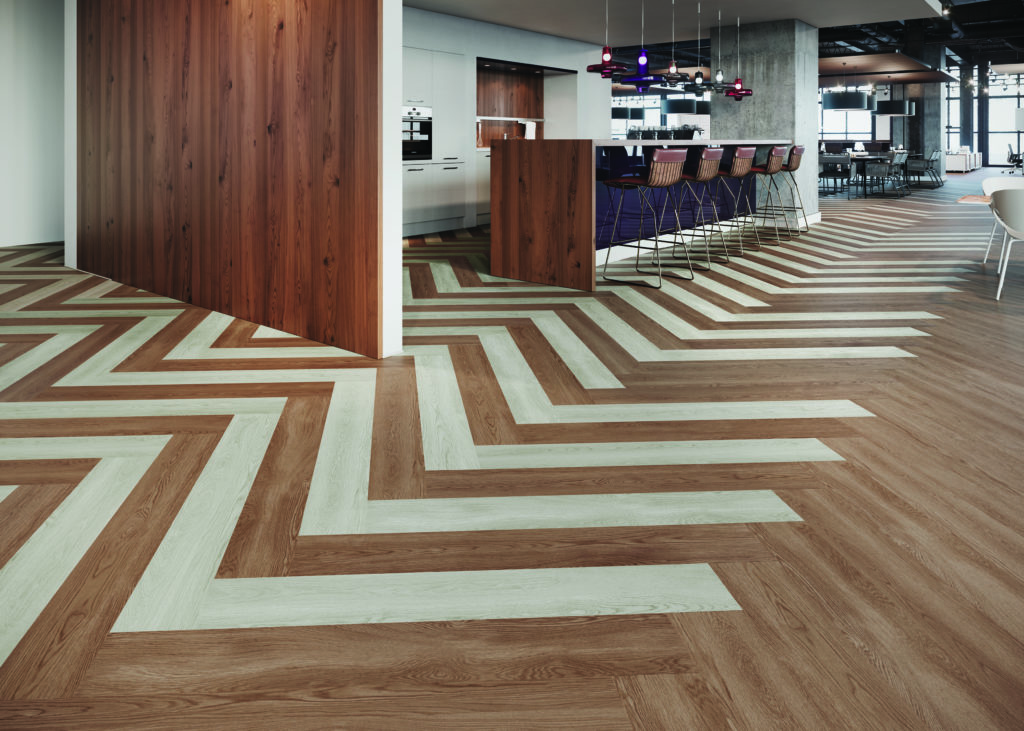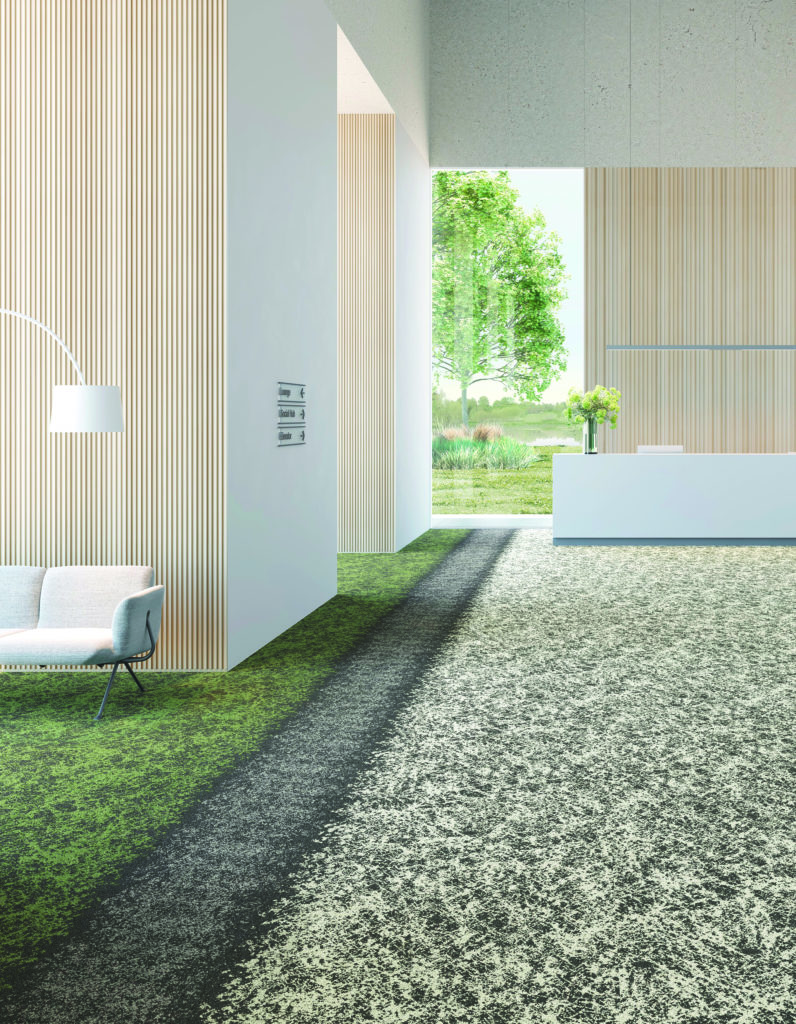By K.J. Quinn

The repercussions of the COVID-19 pandemic have been felt across virtually all sectors of the U.S. economy—and the commercial flooring market is no exception. While no one has a crystal ball as to how things are going to shake out over the medium to long term, some observers say 2019 could be remembered as the last growth year in commercial for some time.
“COVID-19 has had a dramatic impact on every aspect of the economy, including commercial flooring sales,” said John Stephens, vice president of marketing, Shaw Contract.
Heading into 2020, commercial flooring was on pace to sustain modest growth across the board. Soft surface sales showed flat to low single-digit gains, with approximately $3.3 billion generated from specified contract and $625 million sold to Main Street applications, preliminary FCNews estimates show. Volume ranged from 220 million square yards to 280 million square yards.
The majority of carpet sales in the commercial market are generated from specified contract. With respect to specific formats, carpet tile leads the way with roughly 60% market share, a figure that continues to grow as suppliers push the envelope with sustainable products featuring sophisticated designs and low carbon footprints. “Modular carpet is more prevalent across all commercial interior markets as designers, architects and end users have become more familiar with its unique attributes, including its dynamic design capabilities, installation ease and speed,” said Jim Poppens, president, Interface Americas.
Resilient leads the pack
Hard surface, however, remains the shining star for the commercial market, much like residential, with sales growth easily outpacing its sister products. Category sales grew in the single digits to between $3 billion and $3.5 billion last year, while volume rose at a similar rate to between 2.5 billion and 3 billion square feet, estimates show. A little more than half of the volume is from specified contract, while dollar sales are more evenly split with Main Street applications.
Leading the pack, of course, is resilient flooring. Preliminary estimates show resilient represents more than 60% of commercial hard surfaces sales in 2019. Much of this growth, observers say, was driven by which posted double-digit sales increases last year. Advances in styling, performance and maintenance reportedly contributed to boosting market share primarily at the expense of carpet.
“All categories are using LVT and resilient,” said David Thoresen, senior vice president, product and innovation officer, Armstrong Flooring. “It’s being used in public areas, break rooms and even offices are starting to explore it more. Plus, the designs are more attractive.”

An influx of color and design enabled VCT to maintain its appeal to the commercial segment, although growth was limited to certain markets, such as schools and supermarkets. Overall, VCT continued to cede market share, as its percentage eroded to approximately 15% to 19% of specified commercial dollars. “The high life cycle costs and maintenance tarnish the story a little bit,” Armstrong’s Thoresen said. “Some school districts still look at the low initial installed cost, and that’s what they want to talk about.”
Education and health care are the primary end uses for rubber, where approximately 80% of products are sold. Demand for floors that are PVC-free and meet IAQ requirements re helping drive specs. “There is concern for safety, health and hygiene,” said Jeff Trattner, vice president, marketing, Roppe. “Rubber addresses each of these exceptionally well.”
Linoleum sales were essentially flat in the U.S. last year based on roughly $82 million, estimates show. The product is said to be among the most sustainable and durable commercial floors, complemented by distinctive colors and designs.
“The value proposition is among the best in the industry,” said Denis Darragh, general manager, North America/Asia, Forbo Flooring Systems, noting most of linoleum’s sales growth came from health care. “But we don’t think the market is going to be back to where it was for a year.”
Ceramic faces challenges
Ceramic tile has more versatility in commercial spaces than carpet, but for the first time in many years posted flat to negative single-digit growth in both sales and square footage last year. “Labor and LVT continue to be two factors affecting the tile category,” said Mark Shannon, executive vice president of sales, Crossville. “Labor for tile installation has been in tight supply, leading to higher installation costs and longer project lead times.” Estimates show commercial represents less than 30% of total tile dollars and roughly 25% of the volume. “We continue to see the demand for sustainable hard surface product selections,” said Joan Williams, vice president commercial sales at Dal- Tile. “Our company is diligently working to take advantage of this opportunity, especially with our expanded product offering that allows for more areas of applications.”
Conditions vary by segment

Each commercial sector features a unique set of circumstances affecting product specs. Corporate/offices remains the largest with roughly 40% market share, FCNews estimates show. The segment grew during 2019 as more workspaces were updated.
An estimated 20% of LVT commercial sales come from the corporate/office sector. “LVT has grown into the workplace market,” noted Mike Gallman, Mohawk Group president. “You don’t necessarily see it growing into working areas, whereas someone who put in ceramic or wood in the lobby and are now going with LVT.”
Resilient, hardwood, porcelain tile and polished concrete are preferred for certain parts of the office where fashion and functionality are required. “There are spaces putting in concrete—a hot and edgy look—into the workplace and open areas,” Gallman added. “However, it’s still a relatively small part of that market.”
Health care, one of the largest commercial market sectors, continues to post gains, with clinics, assisted-living communities and urgent care centers driving growth. Construction and renovation are rampant in a segment considered among the most challenging environments for the A&D community to service. “The health care segment is anticipated to continue to grow, particularly due to the short- age of spaces available to care for the currently aging population and the high usage of tile in health care buildings,” Dal-Tile’s Williams said.
Health care remains a bedrock segment for resilient sheet goods and rubber, especially in areas requiring high sanitary levels, such as in triage, emergency and operating rooms. Luxury vinyl tiles and planks are finding their way into non-critical areas. “LVT has grown dramatically in patient rooms and corridor areas,” Mohawk’s Gallman observed.
Natural materials such as ceramic are considered healthy choices and more premium products are increasingly being specified throughout health care facilities. “Tile’s low conductivity and unbeatable hygienic qualities have long made it the material of choice for operating rooms and bathrooms in these facilities, and we have seen some growth in public areas also for the same reasons,” said Ryan Fasan, Tile of Spain consultant and ceramic tile specialist.
Similar to health care, the hospitality business saw major investments in remodeling. An estimated 25% of commercial carpet is sold in these spaces, the majority of which is broadloom. “We are also seeing broadloom replaced by carpet tile in guestrooms, but in fewer in- stances than LVT installations,” Shaw’s Stephens said. “Carpet continues to add value to hospitality applications, particularly in many public settings such as ballrooms and meeting spaces.”
Hospitality is among the largest commercial segments for tile, representing approximately 50% of commercial sales. “Gauged porcelain panels add a sense of scale and grandeur to a space when utilized on walls and floors,” Fasan said. “The emergence of 12mm gauge porcelain is creating an entirely new category of tile specifications in the form of restaurant tables and other worktops for hospitality settings.”
Similar to hospitality, there is a diversified amount of flooring specified in education, a market driven in part by approval of government bonds and public funding to support school construction and renovation. K-12 retains the biggest piece of the pie, accounting for approximately 75% of flooring sales, with the rest from higher education.
“While the primary growth was in K-12 schools, we also saw private universities being attributed to much of the growth,” Dal-Tile’s Williams said. “Similar to the corporate/office segment, the competitive environment these establishments face requires their spaces to feel updated, refreshed and inviting.”
Education surpassed hospitality as the second-largest commercial segment for carpet, representing roughly one-third of sales. This segment is dominated by carpet tile, namely because of its installation and replacement advantages. “Education seems to be going with carpet tile in the classrooms, with rubber and linoleum getting a fair amount of interest in the hallways,” said Randy Rubenstein, owner, Rubenstein’s Contract Carpet, Seattle.
Most applications, however, require hard surfaces, representing more than half of flooring sold to K-12 spaces, industry members say. LVT checks most of the boxes for school building needs and nearly every area offers growth opportunities.
An estimated 15% of commercial tile sales come from education, a price-sensitive market where the high installed cost is often a deterrent for specifiers. Premium flooring products, such as porcelain and terrazzo, are utilized for high-traffic areas such as corridors, lobbies and restrooms.
Then there’s retail, where flooring choices run the gamut. Ceramic, wood and carpet are often specified in high-end retail spaces, while resilient, VCT and rubber flooring are found in other public areas. “Retail is going more and more toward hard surfaces,” Mohawk Group’s Gallman said. “There’s still a lot of concrete used in retail, but also a lot of LVT.”
LVT is a popular option in retail spaces, a segment renown for staying on top of interior design trends. “In retail, we are also seeing broadloom replaced with LVT,” Shaw’s Stephens said. “Several larger retail chains still continue to use broadloom consistently in their spaces.”
From main hallways to store interiors, ceramic remains a popular choice, including indoor or outdoor shopping centers and smaller independent stores. The segment represents approximately one quarter of commercial tile sales. “The safety, durability and easy cleaning make them a perfect choice for busy environments,” Tile of Spain’s Fasan said.
Overall, specifiers predict a post-COVID- 19 work environment will have an impact on long-term interior design. Ensuring health and safety will be the primary concern. “This segment embraced open floor plans, which may need to be reconfigured to accommodate social distancing,” Shaw’s Stephens explained. “We are likely to see people look for more flexibility in these spaces, so modular flooring that can be reconfigured easily will likely become more popular.”
Outlook for remainder of 2020
For the first time since the Great Recession, commercial flooring will likely show a decline in overall sales and volume compared to the previous year. So much depends on the ramifications of the coronavirus pandemic, which has thus far trumped all economic indicators, making it difficult to forecast when business conditions will improve.
Viewpoints among industry observers as to the outlook for the commercial market remain mixed. “We predict that business will improve in the latter half of 2020, but the long-term effect of this pandemic is still to be seen,” Shaw’s Stephens said.
Other observers, including Interface’s Poppens, remain cautiously optimistic. “We are hopeful that the economy will begin to stabilize over the next two quarters,” he explained. “It’s hard to anticipate just where things will land.”
